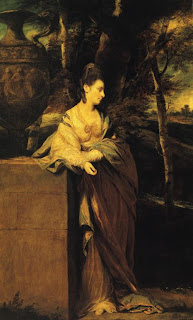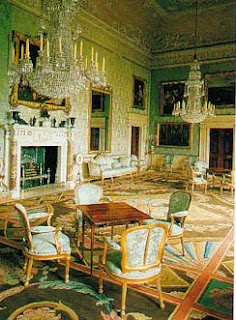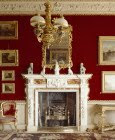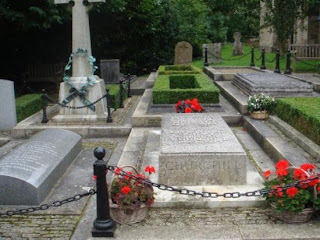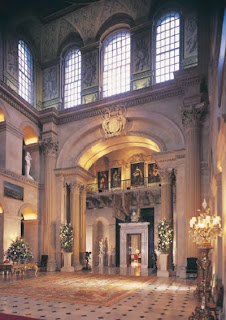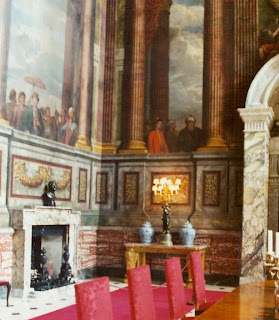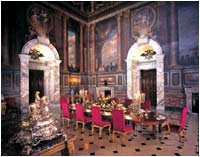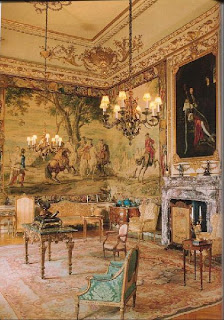Now that I am almost on my way to England, I will post about one of my favorite house visits from past trips. Saltram House is near Plymouth in Devon.
Saltram’s first records indicate the Bagg family built a large Tudor house on the site in the 16th century. After the Civil War, the Carteret family acquired the property and did some remodeling before Parliament allowed them to sell a Crown-granted property to George Parker in 1712.
His daughter-in-law, Lady Catherine Parker and her husband John rebuilt sections of the house and filled their addition with decorations in the rococo style. The architect and artisans are unknown though Lady Catherine herself is said to have been the primary designer. Right, a portrait of Mrs. John Parker by Sir Joshua Reynolds, c. 1770-72.
A central staircase with a glass ceiling was created from the traditional Tudor courtyard in the center of the squarish house. 
Enclosing the courtyard was a relatively new idea at the time, providing bright light to the center of the house and allowing for a grand staircase. In the photo from the 1995 film of Jane Austen’s Sense and Sensibility, Fanny Dashwood peers down at Elinor and Edward, and she thoroughly disapproves of the budding romance.
John II, who became Lord Boringdon in 1784, brought in Robert Adam to re-design unfinished rooms, particularly the Saloon, even now virtually unchanged from the master’s touch. Lord Boringdon was a close friend of Sir Joshua Reynolds, who assisted in the acquisition of Saltram’s fine collection of art, including ten of Reynolds’ works. Several paintings by Angelica Kauffman also hang at Saltram. She often worked closely with Robert Adam.
Left is a self-portrait of Ms. Kaufmann from Saltram.
Also from this period is the design of the gardens, woods and lawns, which today shield the property from the invasion of modern-day Plymouth. Except for a few spots in which young trees replace some old ones lost in storms, the visitor would never know she strolled in the center of a suburban/
industrial environment. Below, snowdrops in early spring at Saltram.
John Parker III, at age 16, became Lord Boringdon upon the death of his father in 1788; he was named first Earl of Morley in 1815. After some years on the Grand Tour, he followed his forefathers by representing the area in Parliament and as a leader in local affairs. But his costly engineering properties for the surrounding region brought debts requiring the family to let the house from 1861 to 1894.
The third Earl, also a politician and statesman, and his son lived at Saltram until 1951 when the house, its contents and 290 acres of park were given to the nation in lieu of death taxes and taken over by the National Trust.
As I already mentioned, Saltram house played the Role of the Norland estate in the 1995 film Sense and Sensibility, adapted by Emma Thompson, which is superior, in my opinion, to later versions.
The Red Velvet Drawing Room, from which Elinor weepily watches Marianne playing the pianoforte in the Saloon and is comforted by Edward, has several noteworthy features. Many of the gilded chairs retain their original red velvet seats. The guidebook compliments the care of the housekeepers, who kept extra covers in place when the family was not entertaining. An old inventory lists a red and white feather duster as part of the room’s furnishings, and indicates that at least one of the Countesses dusted her precious porcelains herself. A pierced gilded fillet surrounds the fireplace and doors, running horizontally along the chair rail, quite evident in the film. While very elegant, this is a comfortable room that would put its occupants at their ease.
 The saloon was used for balls, concerts and receptions, a necessary feature of great country houses. Its Adam-designed formality is as grand as the family rooms are intimate. Walls are covered in pale blue damask, as is the suite of eighteen armchairs and two sofas by Chippendale. Several of Adam’s intricately-detailed drawings for the woodwork, mirrors and fittings hang in the hallway and many others are in Sir John Soane’s Museum in London. Joseph Rose executed the elegant ceiling plasterwork and was paid 434 pounds in 1772. As so often in Adam rooms, the roundels featuring the goddesses Diana and Venus, were painted by Antonio Zucchi and Angelica
The saloon was used for balls, concerts and receptions, a necessary feature of great country houses. Its Adam-designed formality is as grand as the family rooms are intimate. Walls are covered in pale blue damask, as is the suite of eighteen armchairs and two sofas by Chippendale. Several of Adam’s intricately-detailed drawings for the woodwork, mirrors and fittings hang in the hallway and many others are in Sir John Soane’s Museum in London. Joseph Rose executed the elegant ceiling plasterwork and was paid 434 pounds in 1772. As so often in Adam rooms, the roundels featuring the goddesses Diana and Venus, were painted by Antonio Zucchi and Angelica
Kauffmann. The two elaborate 19th century chandeliers now hanging in the saloon were tied out of view for the film.
The first Countess of Morley wrote of a ball at Saltram in 1810, “We lighted it by putting a quantity of candles over the doors, the places in which they were fixed being concealed by large wreaths and festoons of leaves and flowers beautiful to behold…round the room we had two rows of seats affording comfortable anchorage for about 200 persons.”
Of interest to the modern visitor is the Great Kitchen containing an open range dating from 1810. A collection of more than 600 copper pans and utensils is on display. In 1788, the kitchen staff included a cook, kitchen maid, scullery maid and still-room maid, in addition to other indoor servants: a governess, the housekeeper, two housemaids and the butler’s staff of an underbutler, two footmen and a brewer. In 1811, each bedroom was provided with a copper can of hot water at least twice a day.
The grounds contain several gardens, an orangery (right), follies, stables and a chapel. Parts of the estate are being preserved as wildflower and wildlife habitats. While wandering the lawns admiring the view of the river Plym or the sheep and cattle across the ha-ha, only the faint sounds of the nearby motorway might remind the visitor of the 21st century. But a careful reading of the guide book reveals that the ha-ha was constructed in 1963; until then, the cattle grazed right up to the buildings. And, as always in NT properties, the temptations of the well-stocked gift shop and the delights of the tea room are features I love, though they weren’t available to early 19th century guests.

